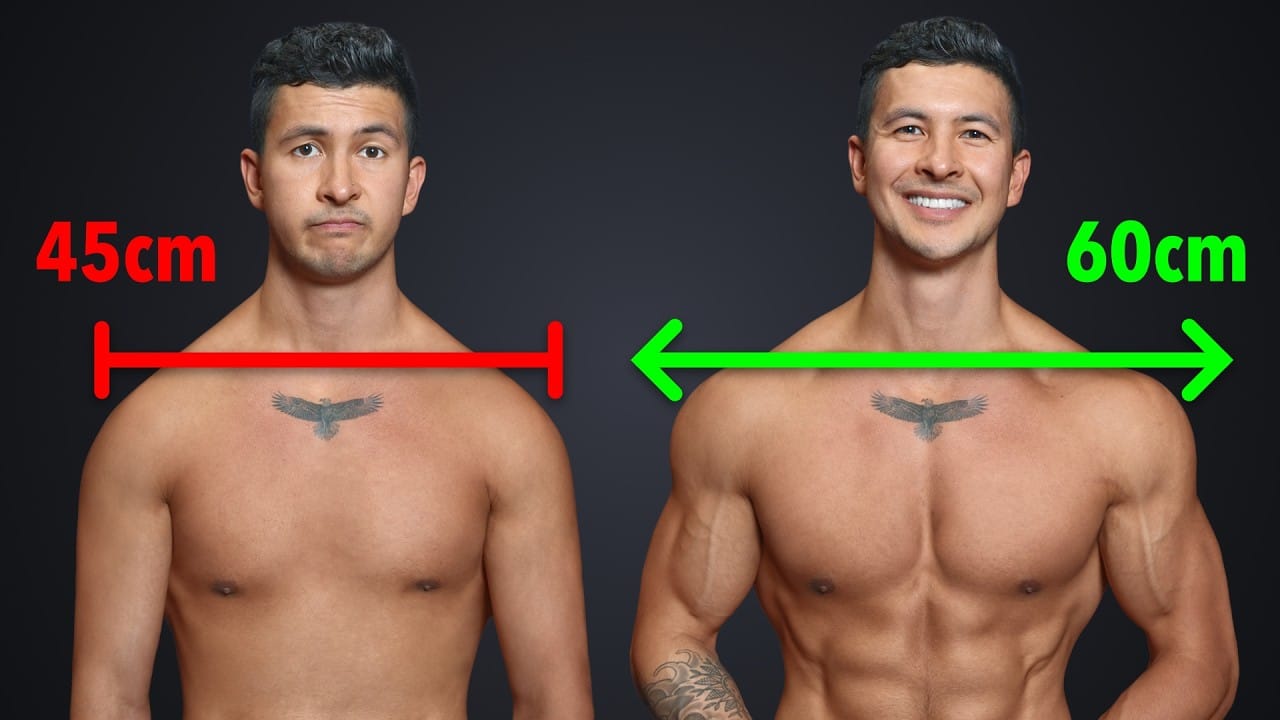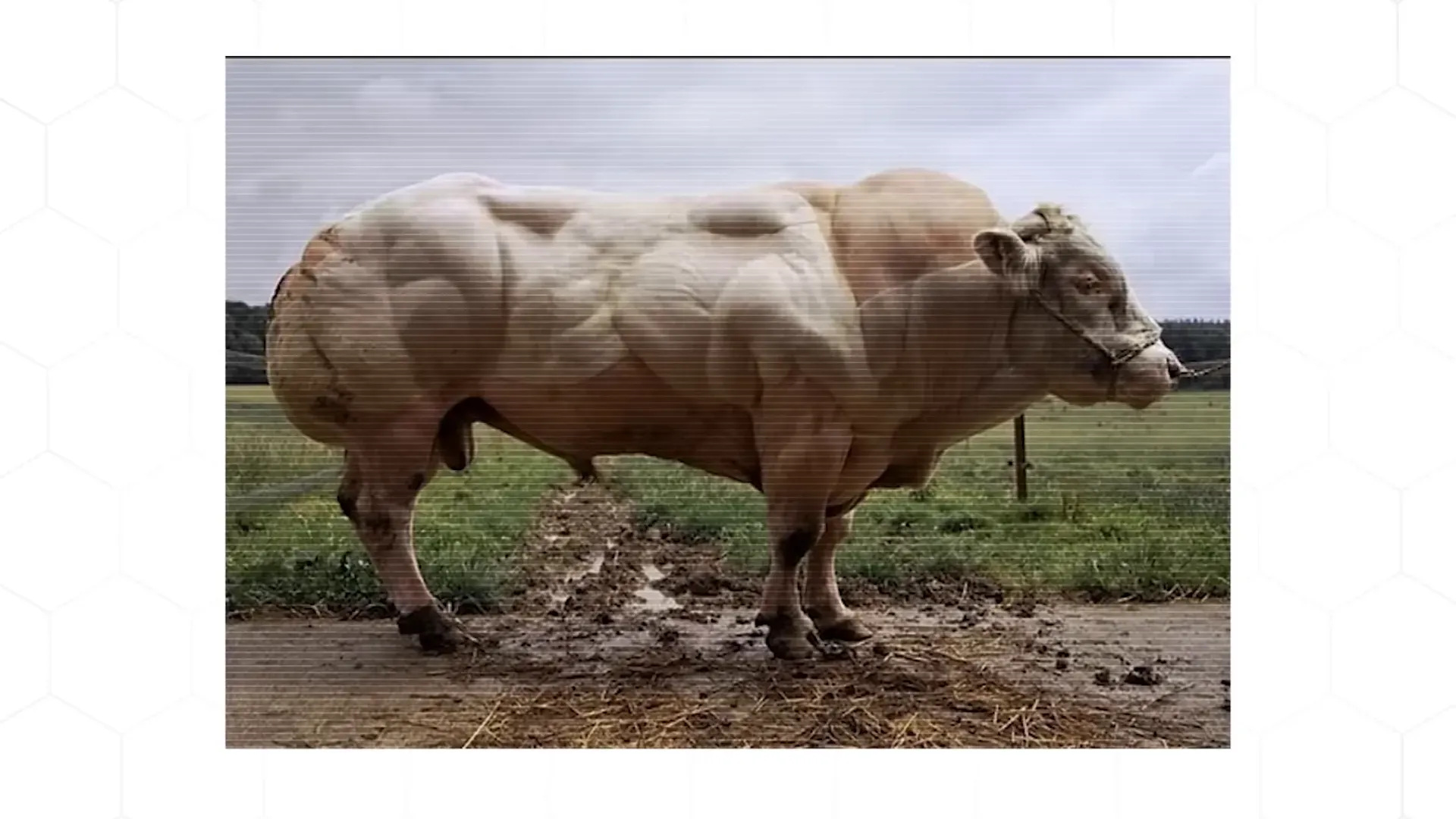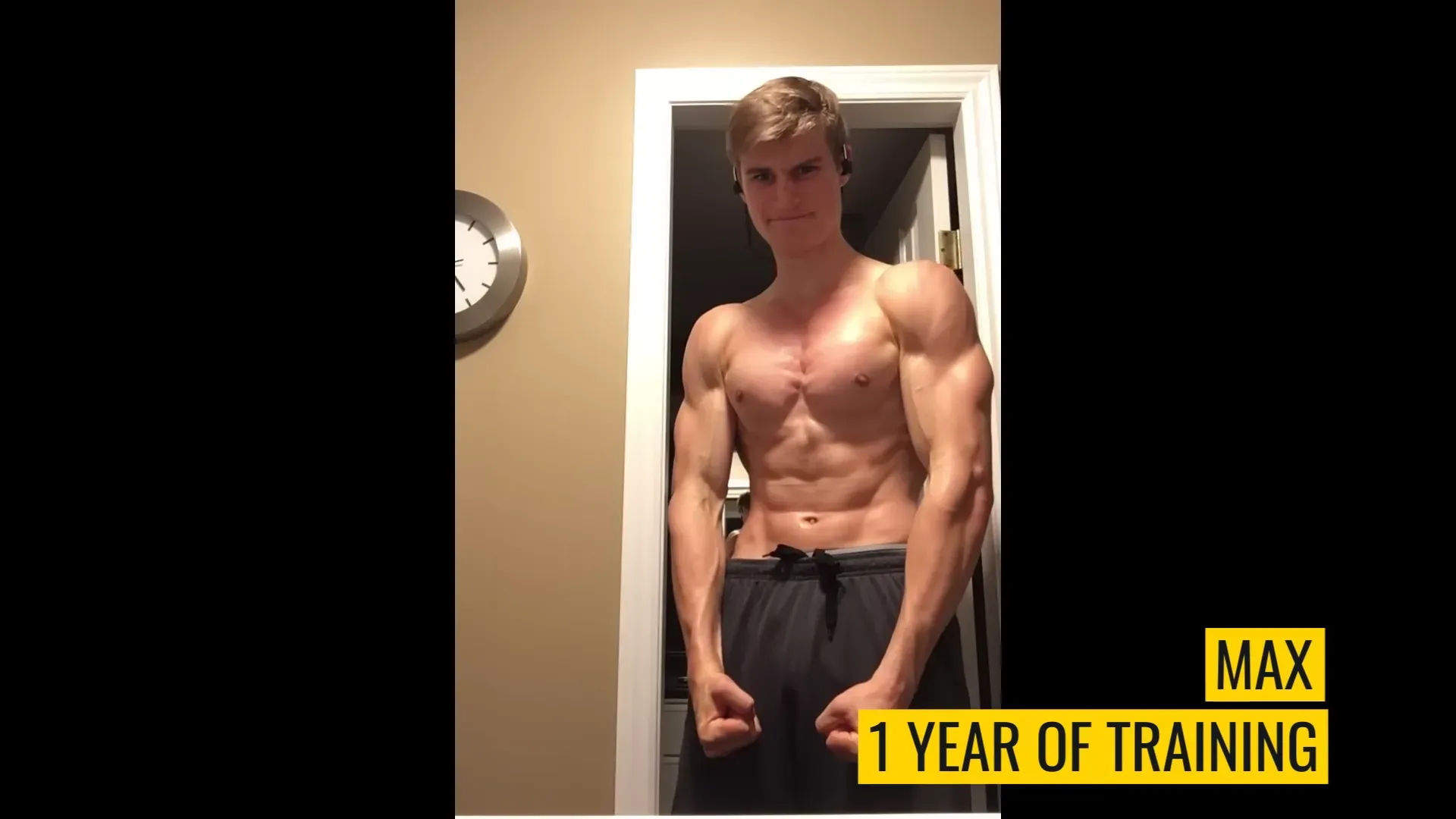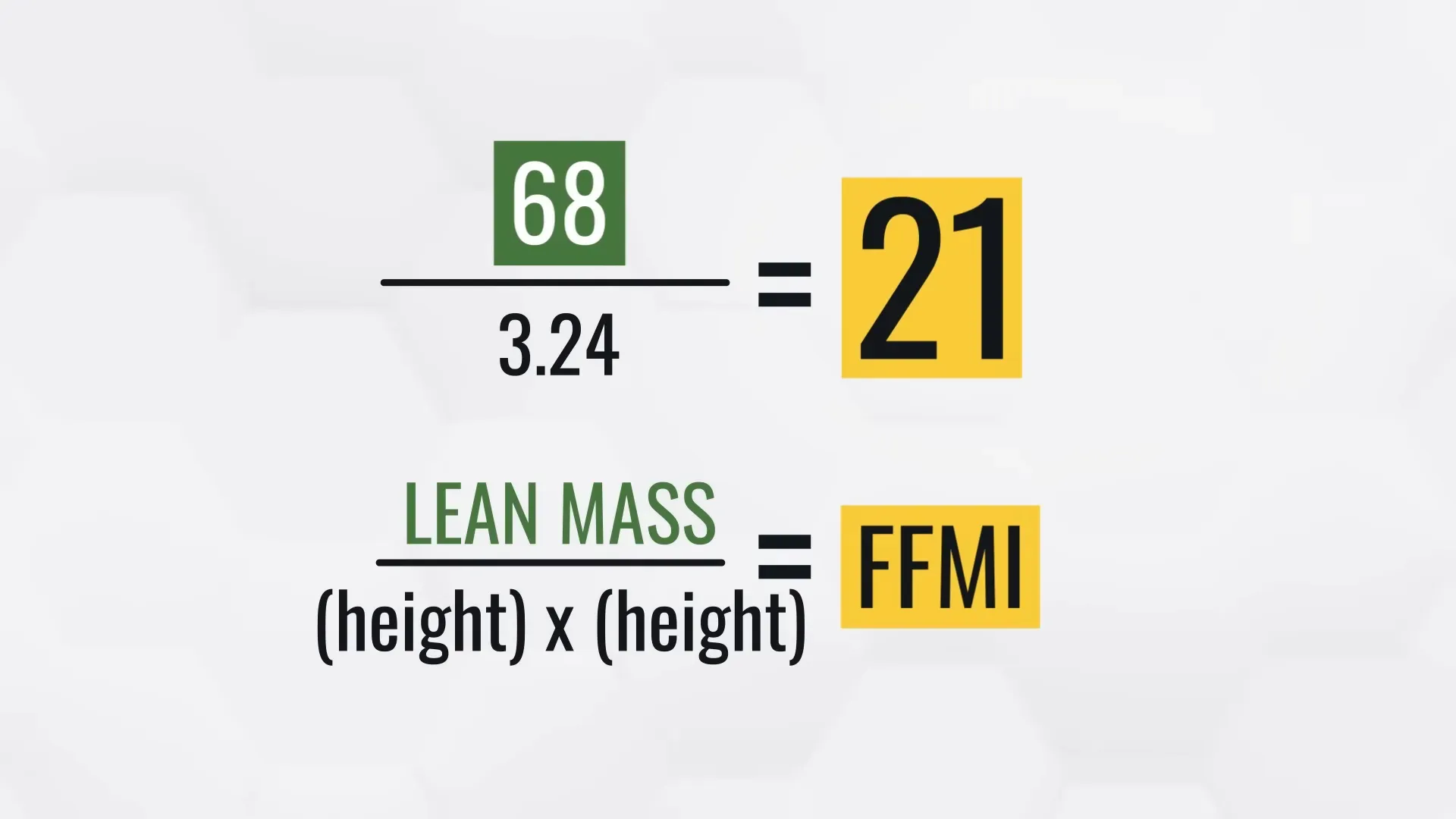Beat Your Genetics: Build More Muscle, Lose More Fat
Science-backed strategies to improve your muscle growth, shape your frame, and boost your results

Key takeaways
- You can improve your muscle growth by increasing weekly training volume intelligently — aim for 12+ sets per muscle when starting out.
- Specialize: spend your volume budget on 1–2 priority muscles to create major visual changes in months.
- Measure your natural limit with FFMI so you set realistic goals — leaning out often gives the biggest visual returns.
Try this today
✔ Add 2 hard sets to your lagging muscle group this week and track how that group feels across two sessions.
Want to build more muscle and look leaner? You can. You don’t need a perfect frame to make real change. You need a plan that matches your genetics, recovery, and goals.
In this expert review, we analyze, critique, and expand on Jeremy Ethier’s science-backed approach to beating poor muscle genetics. We pull out what works. We correct what needs clarity. We give you clear steps to get more muscle, less fat, and an improved physique.
What makes this review different?
- Carefully reviewed and fact-checked by experts
- Little-known tips to maximize visual impact with limited recovery
- Complete workout plan inspired by focused specialization and progressive volume
Why should you listen to us? We've published 300+ articles, all rigorously reviewed by an exercise scientist with 25+ years of real-world training experience.
Keep reading. You’ll learn how to tell if your genetics are helping or holding you back. You’ll learn practical ways to push past limits. And you’ll get a usable program you can start this week.
Related:
- How to gain muscle & lose fat: 4 steps with meal plan
- Volume & muscle hypertrophy
- How to build muscle (complete guide)
In a Nutshell: Beat your genetics
You can’t change your bones. But you can change how you use them. Your genetics set starting points. They don’t set your endpoint.
You can gain meaningful size in year one with the right volume. You can push a lagging muscle ahead by spending your volume budget on it. And you can use FFMI to set realistic targets and avoid wasting years chasing impossible numbers.
Follow the process and commit to smart training, sleep, and nutrition.
Key concepts
- Responder types: People vary — hyperresponders grow 2–3x faster than low responders
- Training volume: Sets per muscle per week largely control growth when other factors are in place
- Specialization: Focused extra volume on 1–2 muscles yields big visual returns
Why your genetics are only the starting line
Let’s be blunt. Genetics affect three things that matter: how fast you build muscle, which muscles come easily, and your theoretical natural limit. All three matter. But they don’t hand you a life sentence.
First, speed. Some people are wired to add size quickly. Others need time. A study put 287 people on the same full-body plan twice weekly for six months. They used MRI and DEXA. Results varied wildly. Researchers split responders into three groups. Hyperresponders gained dramatically — two to three times more than average. Most people were average responders and gained modestly. Low responders barely gained.
That means two people can follow the same plan and walk away with very different results. It sucks to watch that, but it also tells you something useful: if you are a low responder, you can change the inputs. You can improve your nutrition, sleep, recovery, and yes, training volume to get closer to someone who seems to grow faster naturally.
Myostatin and rare mutations
Myostatin is a powerful hormone that limits muscle growth. In animals, removing it produces massive muscle gains. In humans, rare mutations cause extreme muscularity from childhood. The case reports are fascinating, but also rare — maybe 4 per million people. Most of us will never carry such a mutation. Still, the existence of myostatin shows how biology shapes potential. It doesn’t tell you what to do in the gym. That part is still about effort and smart planning.

How to tell if your genetics are working for you
Bone structure matters less than people think. Wide clavicles make you look broad. Narrow clavicles make you look slim. But wide shoulders don’t mean you’ll build faster. A study found wide-framed people started with more muscle. But their rate of gain was nearly the same as narrow-framed people. The visible advantage comes from the starting shape, not the growth rate.
A better metric is how quickly you gained strength and muscle in your first year of training. If you saw big changes fast, you likely are a stronger responder. If you made small changes, you might be a low responder. But that’s not a prison sentence. It tells you where to allocate effort.

Strategy 1 — Training volume: the most powerful lever you can flip
The number of working sets per muscle per week. It’s the single best predictor of hypertrophy when intensity and effort are reasonable. If you want to beat a slow-growth rate, volume is the lever you pull.
Here’s how to apply it.
Start points based on your current volume
- If you do under 12 sets/muscle/week: this is your sweet spot. Add 20–30% volume and your gains will speed up significantly. That could mean adding 2–4 sets to major muscle groups each week.
- If you do 12–20 sets/muscle/week: gains continue but with diminishing returns. Only add more if form, intensity, and recovery are dialed.
- If you do over 20 sets/muscle/week: you’re at a point of small returns. Most lifters don’t need to push past this without careful planning.
Why does this matter? Because low responders often undertrain. They never hit the volume threshold needed to maximize their available growth. Raising volume in a controlled way can make a low responder look like an average responder.
How to add volume safely
- Add gradually. Add 1–2 sets per muscle per week, per training block. Ramp over 4–8 weeks.
- Spread sets across at least two sessions per week for each muscle to aid recovery and maintain quality.
- Keep intensity high. Work sets should be near failure within your planned rep range. Don’t add junk volume.
- Monitor recovery. Sleep, appetite, soreness, and performance are your guides.
Dr. Eric Helms’s experience mirrors this. He usually sees his fastest gains when he increases volume. A crossover study he co-authored found that people respond better to higher volume on average. There wasn’t a subset who uniquely did better with lower volume. That supports a general push toward more work, carefully applied.
Strategy 2 — Specialization: spend your volume where it matters most
Volume is finite. You can only recover from so much work. So use that capacity where it moves the needle visually. Specialization means bringing one or two muscle groups above maintenance and letting less important areas stay at low but sufficient stimulus levels.
That trick is how you can look 10 pounds heavier after months of focused work without huge total mass gains. The visual change comes from shifting proportions.
How I used specialization
My frame is narrow. My clavicles are short. A lot of early training felt futile. One year I put everything else on maintenance. I focused almost entirely on shoulders. I trained them twice weekly and slowly raised shoulder volume to about 20–30 sets per week while holding other muscles at 8–10 sets. Visual change followed. My shoulders looked wider and more imposing. The V-taper improved.
How to apply specialization
- Pick one or two target muscles. Guys: shoulders or arms. Women: glutes or shoulders. Pick what hurts your confidence most.
- Start those muscles at ~10 sets per week across two sessions.
- Add about 2 sets per week (total) every 1–2 weeks until you reach 20–30 sets per week. Watch recovery.
- Cut other muscles to maintenance: 8–12 sets per week. For your naturally strong areas, 4–6 hard sets per week can maintain size.
- Run the block for 8–16 weeks. Evaluate. Repeat or switch focus.
Examples of focused volume: Brett Contreras often prescribes 30–40 sets per week for glutes over several sessions. It works. My partner followed a similar plan and built a dramatically fuller glute shape in months.
Strategy 3 — Measure your ceiling with FFMI (and aim smart)
FFMI, or fat-free mass index, gives you a way to set realistic muscle goals. It’s lean mass (kg) divided by height squared (m²). Higher FFMI equals more muscular. Use it as a reality check and a way to prioritize being lean.
Examples of FFMI ranks:
- About 18: average lean person
- 20–21: athletic, lean look like Brad Pitt in Fight Club
- 22–23: highly muscular natural lifter
- 24+: top 1% of natural lifters
- 28–30+: typical of elite enhanced physiques
Use the FFMI calculator at builtwithscience.com/ffmi to get your number. Then work backward. If you’re at 20 and want 23, calculate lean mass needed and set a concrete target — say 8 lbs of muscle. That gives you timeframes and a realistic plan.

Why being lean wins visually
Two men with identical muscle mass but different body fat percentages will look very different. Leaner always looks more muscular. Bruce Lee and Fight Club Brad Pitt didn’t have huge FFMI values, but they looked shredded and athletic. For most people, dropping body fat while gaining some lean mass produces the biggest visual returns faster than chasing huge muscle numbers.
Putting it together: a sensible road map for most lifters
Here’s the sequence you should follow if you want real progress and want to beat bad genetics.
- Audit your current training and nutrition. Track sets per muscle per week. Track calories and protein.
- If you do under 12 sets/muscle/week, plan a slow 20–30% volume increase over 4–8 weeks.
- Pick one or two focus muscles to specialize for a 8–16 week block. Move volume into them and reduce other muscle work to maintenance.
- Prioritize sleep, protein, and progressive overload. No volume plan helps without effort and recovery.
- Use FFMI to set realistic medium-term targets. Be lean to look better sooner.
Program: Specialize to win — 8-week block for shoulders (example)
This workout includes focused shoulder volume while maintaining other muscle groups. It’s based on the insight that specialization and controlled volume yield fast visual change. You can adapt the same model to glutes, arms, chest — whatever your priority is.
Program overview
- Ideal for: lifters with narrow shoulders who want a wider look
- Equipment needed: barbell, dumbbells, cables, bench, pull-up bar
- Block length: 8 weeks
Weekly layout
- Day 1 — Upper A (shoulder focus) — heavy compound pressing and targeted lateral work
- Day 2 — Lower A — standard lower body hypertrophy
- Day 3 — Upper B (shoulder volume) — more isolation and higher rep work
- Day 4 — Full Body or Active Recovery — light maintenance for lagging muscles
- Day 5 — Lower B — second lower session
- Optional additional upper maintenance day if recovery allows
Day 1 — Upper A
- Barbell seated or standing overhead press — 4 sets × 6–8 reps — rest 90–120s
- Incline bench press — 3 sets × 8–10 reps — rest 90s
- Dumbbell lateral raise — 5 sets × 12–15 reps — rest 60s
- Face pulls — 3 sets × 12–15 reps — rest 60s
- Biceps curl (optional) — 2 sets × 10–12 reps — rest 60s
Pro tips:
- Make the overhead press your heavy anchor. Build strength here to increase load for hypertrophy later.
- Keep lateral raises strict. Don’t swing the weight. Slow negatives help.
- Face pulls protect your shoulders and help them look fuller from the rear.
Day 3 — Upper B
- Seated dumbbell press (lighter) — 3 sets × 8–12 reps — rest 90s
- Cable lateral raise (leaning) — 4 sets × 12–15 reps — rest 60s
- One-arm dumbbell front raise — 3 sets × 10–12 reps — rest 60s
- Rear delt dumbbell fly (incline bench) — 3 sets × 12–15 reps — rest 60s
- Triceps pushdown — 2 sets × 10–12 reps — rest 60s
Pro tips:
- Use tempo to create time under tension on isolation moves (2–3s eccentrics).
- Keep each session focused and finish with lights to avoid blowing out recovery.
- If you feel systemic fatigue, drop a set or cut a small exercise rather than lowering quality.
Lower days (Day 2 & Day 5)
- Squat variation — 3–4 sets × 6–10 reps
- Romanian deadlift — 3 sets × 8–10 reps
- Leg press or lunges — 3 sets × 10–12 reps
- Calf work — 4 sets × 12–20 reps
Pro tips:
- Keep lower body work solid but don’t overdo volume—you want recovery left for shoulders.
- Focus on quality reps and progressive overload across the block.
Notes on program execution
- Start the block with a deload week if you’ve been training very hard previously.
- Track sets per muscle per week. Aim to reach 20–30 weekly sets for shoulders by week 4–6.
- Eat to fuel growth. If you want to add muscle, target a small calorie surplus (≈200–300 kcal/day) and 0.8–1.0 g protein/lb of bodyweight per day.
- Sleep 7–9 hours. Prioritize uninterrupted sleep.
Two short paragraphs to conclude:
Specialization forces your body to invest its limited recovery into one area. That creates visual change. It’s simple and it works. Keep other areas at maintenance to avoid wasted recovery.
Want to automate workouts like that and more? Put your progress on autopilot with Dr. Muscle AI. Try it free: https://dr-muscle.com/discount/
Expert Corner: Proven Strategies & Hidden Gems
Now I switch hats. I speak as a scientist who reviewed the claims, checked the logic, and weighed the practical value for real trainees. I’ll give you deeper, evidence-informed context and some lesser-known tips that matter in practice.
Practical Applications
- Volume ramping: Increase sets by 10–30% depending on your baseline. If you do 8 sets per week for chest, add 2 sets initially and re-evaluate in 2–4 weeks.
- Split your sets: Train a muscle at least twice weekly. Spread 20 sets across two or three sessions to keep quality high. Example: 10 + 10 for shoulders, not 20 in one brutal session.
- Specialization cycle: Block 8–16 weeks for one muscle. Start at 10 sets/week, increase two sets each week until you hit 20–30 sets. Maintain others at 8–12 sets/week.
Examples:
- Example A — Glute focus: Week 1 = 12 sets spread Mon/Wed/Fri. Ramp 2 sets/week to 28 sets by week 9, keep hamstrings and quads at maintenance sets.
- Example B — Arm focus: Biceps 10 sets one week, then 12, 14, 16 across six weeks while chest stays at 8 sets — visible arm growth without huge mass gain.
Fact-Check of Key Points
- "Hyperresponders grow two to three times faster" — True as a description of the response distribution. Studies show broad variability when 287 people train the same way. Reality: expect variability and track progress, not assumptions.
- "Myostatin mutations cause massive growth" — Accurate. Rare human cases and animal models show the effect. But it’s extremely rare and not a practical lever for most lifters right now.
- "Higher volume benefits most people" — Supported. The crossover limb study suggests higher volume tends to outperform lower volume when intensity and effort are matched. Caveat: recovery and program quality matter.
- "Specialization makes you look like you gained 10 lb" — Plausible. Shifting proportions by adding 1–2 inches to the shoulder can create a dramatic visual effect, similar to adding 10 lb of mass overall.
- "FFMI gives a ceiling estimate" — Useful and practical. FFMI provides context and realistic target setting, though individual variation still exists.
More Little-Known Tips for Faster Visual Change
- Train lagging muscles with a mix of ranges. Use heavy compound work and also include higher-rep isolation to hit different fibers and angles.
- Use short microcycles: every 3–4 weeks, tweak rep ranges to avoid stalls. For instance, 3-week waves at 6–8, 8–12, then 10–15 reps.
- Prioritize movement patterns not individual exercises. If a particular exercise causes pain, swap but keep the stress on the muscle similar.
Common Mistakes & How to Fix Them
- Mistake: Cranking total volume without quality control. Fix: keep most sets close to failure and maintain form. Reduce sets where rep quality drops.
- Mistake: Spreading volume too thinly across too many muscles. Fix: consolidate volume to priority areas for blocks of 8–16 weeks.
- Mistake: Ignoring nutrition and sleep. Fix: get protein right (0.8–1.0 g/lb), a small surplus for growth, and prioritize 7–9 hours of sleep.
My Opinion on beating 'bad' genetics
I think genetics are a simple explanation for complex problems. People like to blame it. I disagree with defeatism. You can widen your shoulders via training and specialization. You can change proportions. You can improve your FFMI slowly and lean up for dramatic results.
I also disagree with the idea that everyone should chase maximal size. Most lifters should chase proportion, leanness, and functional strength. That’s where the biggest payoffs are. The best public examples are rarely the biggest men in the gym. They are the most proportionate and lean.
I believe in progressive volume, not reckless volume. I want people to train more intelligently. Stepwise increases work. Track sets per muscle. Prioritize recovery. That will beat poor genetics more often than trying every new supplement or miracle program.
Finally, the audio-visual muscle porn of extreme quick transformations obscures the work. Most fast-looking guys trained smart or had rare genetics. If you’re not in that top tier, you can still achieve a great body. You just need a sensible path.
Concluding on what actually matters
Here’s the insider perspective: genetics influence starting points. They don’t decide everything. Your controllables decide most of your success — training volume, exercise choice, recovery, and nutrition. Specialization is a low-risk, high-return method to alter your proportions in months, not years.
A final practical note: don’t chase big numbers for their own sake. Use FFMI to set realistic intermediate targets. Prioritize leanness for immediate visual gains. And slowly build volume where your body needs it. That approach beats frustration and yields lasting results.
Want to automate everything discussed and put your training on autopilot? Dr. Muscle builds programs that adapt volume, prioritize weak points, and progress you intelligently. Try it free.
FAQ
What is training volume and why does it matter?
Training volume is the total number of working sets per muscle per week. It matters because it drives hypertrophy when intensity and effort are sufficient. For most lifters, increasing volume from under 12 sets to the 12–20 range yields clear gains.
How do I know if I am a low responder?
You may be a low responder if you made minimal visible change in your first year despite consistent training and nutrition. Check logs for progress in reps, loads, and body composition. Also audit sleep and protein — many presumed low responders simply under-recovered or under-ate.
How many sets per week should I do for shoulders?
Start shoulders at about 10 sets per week across at least two sessions. Slowly add 2 sets per week up to 20–30 weekly sets if your recovery allows and quality remains high. Track soreness and performance to guide adjustments.
What is specialization training and when should I use it?
Specialization training concentrates extra volume on one or two muscles while holding others at maintenance. Use it when a single area limits your aesthetic goals, such as narrow shoulders or small glutes. Run blocks of 8–16 weeks and re-evaluate.
What is FFMI and how do I calculate it?
FFMI stands for fat-free mass index. It’s lean mass (kg) divided by height in meters squared. Use a DEXA or body fat estimate to find lean mass. FFMI helps set realistic natural muscle targets and track where you are relative to natural limits.
Should I try to block steroids or myostatin inhibitors?
Myostatin inhibitors and steroids are separate issues. Myostatin-related mutations are exceedingly rare and unethical to pursue medically for aesthetic reasons. Steroid use has real risks. Focus on training, nutrition, and recovery first — most lifters can make outstanding progress naturally.
How fast can I expect to gain muscle naturally?
Average lifters can expect ~8–10 lbs of muscle in year one, ~5 lbs in year two, and less each year after. Low responders may gain about half that, while hyperresponders can gain much more. Progress depends on training quality, nutrition, sleep, and genetics.
How should I prioritize diet for specialization?
Support growth with a modest calorie surplus (≈200–300 kcal/day) and consume 0.8–1.0 g of protein per pound of bodyweight daily. If you prefer to stay lean, aim for body recomposition with high protein and strategic calorie cycling while running specialization blocks.
Is it better to be lean or heavy to look jacked?
Being lean gives a stronger visual impression of muscularity. Men with moderate FFMI but low body fat often look more impressive than heavier, softer guys. Prioritize lean gains for maximal cosmetic impact.
How often should I change exercises in a specialization block?
Keep core movements for consistency and progress. Change accessory exercises every 4–6 weeks to address weaknesses and maintain stimulus variety. Don’t switch too often; consistency is key for hypertrophy.
Final note
Genetics are your starting point. They are not your destination. Use volume, specialization, and realistic FFMI targets. Sleep, protein, and progressive overload win in the long run. If you want to automate these principles, try Dr. Muscle AI to build a plan that adapts as you progress.
We used AI to summarize the video How to BEAT Your Crappy Genetics (Using Science) while drafting this expert review.

